Invasive Species
In the context of parks and protected areas, invasive species are a direct threat to maintaining ecological integrity. Once established, some invasive species can be extremely difficult to control or eradicate, and their ecological effects could therefore become irreversible. Preventing the introduction and establishment of invasive species is the most effective approach, and helps to maintain ecological integrity.
The Provincial Parks and Conservation Reserves Act, 2006 restricts anyone from introducing into, or possessing an invasive species in a provincial park. The Algonquin Provincial Park Cottage Lot Policy (2018-2038) specifically prohibits cottagers from introducing, planting or otherwise possessing on their cottage lots, any species of plant or animal that is not native to Algonquin Provincial Park. Cottagers will also be required, as part of eligibility requirements, to remove all species of plants that are not native to the park and to ensure that these species do not re-appear on their cottage lot.
This document will help cottagers understand the potential impacts that non-native and invasive species can have on Algonquin’s ecosystems, how to identify some of the more common and most damaging invasive species, and how these species can be controlled.
For more general information on invasive species in Ontario, see: https://www.ontario.ca/page/invasive-species-ontario

Table of Contents
- 1.0 Invasive Species 101
- 1.1 Controlling and Disposing of Non-native and Invasive Species
- 2.0 Invasive Species Identification
- 2.1 Japanese Knotweed
- 2.2 Phragmites
- 2.3 Dog-strangling Vine
- 2.4 Goutweed
- 2.5 Periwinkle
- 2.6 Daylily
1.0 Invasive Species 101
This section outlines some of the basic ecological characteristics of the most common invasive species in Algonquin Provincial Park.
What are they?
An Alien Species or Non-native Species is a species of plant, animal, or microorganism that has been introduced outside of their natural historical or present distribution. Species that were not historically in the park but are now present as a result of human activities would fall into this category.
An Invasive Species is an alien species that causes harm to the environment, the economy, or society, including human health. The worst invasive species typically have high growth rates or reproductive rates, and if left unmanaged will outcompete native species for food or habitat, resulting in ecosystem degradation.
Common characteristics of Invasive Species include:
• Few natural predators
• Adaptable
• Reproduce quickly
• Thrive in disturbed ecosystems
• Out-compete native species for food and habitat
In some areas invasive species have arrived relatively recently, and it is important to limit or eradicate these populations as soon as possible to mitigate their environmental impacts. Preventing the introduction or establishment of invasive species is often the most effective management approach, and therefore education on species identification is crucial. Eradicating new patches of invasive species is also extremely important, as even small populations of invasive species can grow to a seemingly unmanageable size in a short period of time if left unchecked.
Why are they a threat?
Invasive species are a direct threat to protected areas because they have obvious negative effects on the ‘composition and abundance of native species’, and are therefore a negative influence on ecological integrity.
Where an invasive species has taken the place of a native species, they can disrupt food chains and lead to a reduction in biodiversity. For example, if an invasive plant species is displacing a native species that would normally produce food or habitat for wildlife, then the impacts of this invasive species may be felt throughout the ecosystem. Invasive plants in particular are a concern because they can form dense colonies, or are very aggressive competitors, and can quickly choke out native plant species and disrupt ecosystem processes (e.g. forest succession).
1.1 Controlling and Disposing of Non-native and Invasive Species
The most efficient approach to controlling invasive plant species is to focus on removing satellite populations or limiting plants before they start to dominate large areas. This reduces their likelihood of spreading to other areas, and mitigates their overall impacts on Ecological Integrity. If left unmanaged, most invasive species will outgrow other species and displace the native plant community of an area. There are some simple steps to eradicating or managing invasive plant species, including removing the entire plant (e.g. digging or pulling), cutting above ground vegetation, tarping the area, or using chemical control.
Digging/pulling
If possible, removing the entire plant including both above ground vegetation and the plant’s root network can be very effective. This can be done by digging the entire plant from the ground, or in some cases, pulling the plant out of the ground as long as the root system comes with it. This approach can be labour intensive, but also removes the most plant material from the site. Some invasive species have large root systems and will quickly re-sprout if the roots are not completely removed. If the plant has been established for a long time and has an extensive root system, it may be difficult to completely remove on the first attempt. However, if the plant re-sprouts, then the location of the missed root system will be revealed and this area should be targeted for the next removal. This process may need to be repeated many times before eradication of the invasive species is achieved. Depending on the time of year and/or the plant species, care should be taken to not leave any plant material or seed on site after removal. Some invasive plants can regrow from a single piece of stem or root, therefore any vegetation must be disposed of appropriately (see Disposal).
Cutting
Cutting above ground vegetation can be effective at controlling invasive plant species and limiting their growth, if done at a regular interval throughout the growing season (e.g. once a month). Continual cutting will eventually weaken the root system, decreasing the plant’s ability to regrow. Some invasive plants can regrow from a single piece of cut stem or root, therefore any cut vegetation must be disposed of appropriately (see Disposal). Cutting is often used to control invasive plants prior to chemical control, and facilitates the most effective use of herbicide.
Tarping
In some areas, using a heavy tarpaulin to cover an area infested with invasive species can effectively kill the plants. Covering plants with a tarpaulin will limit the amount of sunlight and moisture available, thereby preventing growth. By using a dark coloured material to cover the plants in sun exposed areas, the microclimate underneath will become so warm that the effect will be similar to cooking the plants. Edges of the tarpaulin should be weighted down to prevent light from entering underneath, and to prevent the tarpaulin from blowing away. Tarping is typically most effective when started in the spring, and is not recommended in low-light areas. The tarpaulin may need to be in place for more than one growing season for effective control, depending on the persistence of the invasive species. For some invasive species, plants will need to be dug or cut beforehand, so that the tarpaulin can lay close to the ground. An area larger than the infestation should be covered by the tarpaulin, as some invasive species will send out shoots laterally to find light. This method can be labour intensive, as the tarpaulin needs to be monitored for plants growing through or from the edges of the tarpaulin. As tarping kills all plant life in the area that it covers, replanting with native vegetation once control measures are complete may be required.
Chemical Control
In some circumstances controlling and eradicating persistent invasive plant species may require the use of herbicides. Cottagers are not permitted to use herbicides unless authorized by the Ministry. In situations where herbicides will be effective, some preliminary work may be required (e.g. cutting of vegetation). If you think that chemical control is required to manage an invasive species, or if the species profile indicates that herbicide may be the most effective treatment, contact Ontario Parks for further information at algonquin.cottages@ontario.ca or 705-645-7436.
Disposal
Great care must be taken when disposing of invasive plants because some species can regenerate and/or colonize new areas from a single piece of rhizome, root stock, seed, or above ground vegetation.
Disposal of all invasive species should be done by:
- Placing all plant material in heavy duty, construction grade black garbage bags. Seal the bags tightly, and cover any holes in the bag (e.g. with tape). When bagging root material, minimize the amount of soil being disposed of.
- Garbage bags with plant material may be left in direct sunlight for a week or longer, to help kill plant material.
- Care should be taken to not rip or otherwise put holes in the garbage bags so that the plant material remains contained.
- Garbage bags with invasive species should be placed in the designated garbage receptacles, or otherwise disposed of in landfill. Unfortunately, because invasive species can be spread during the disposal process and living plant material may survive, they cannot be composted.
2.0 Invasive Species Identification
This section includes information on some invasive species known to occur in Algonquin Provincial Park. Species included here are of importance either because they are some of the worst invasive species (e.g. Japanese Knotweed), or because they are a commonly observed invasive species (e.g. Daylily) on cottage lots. Additional species profiles and/or information will be added as required and available.
2.1 Japanese Knotweed
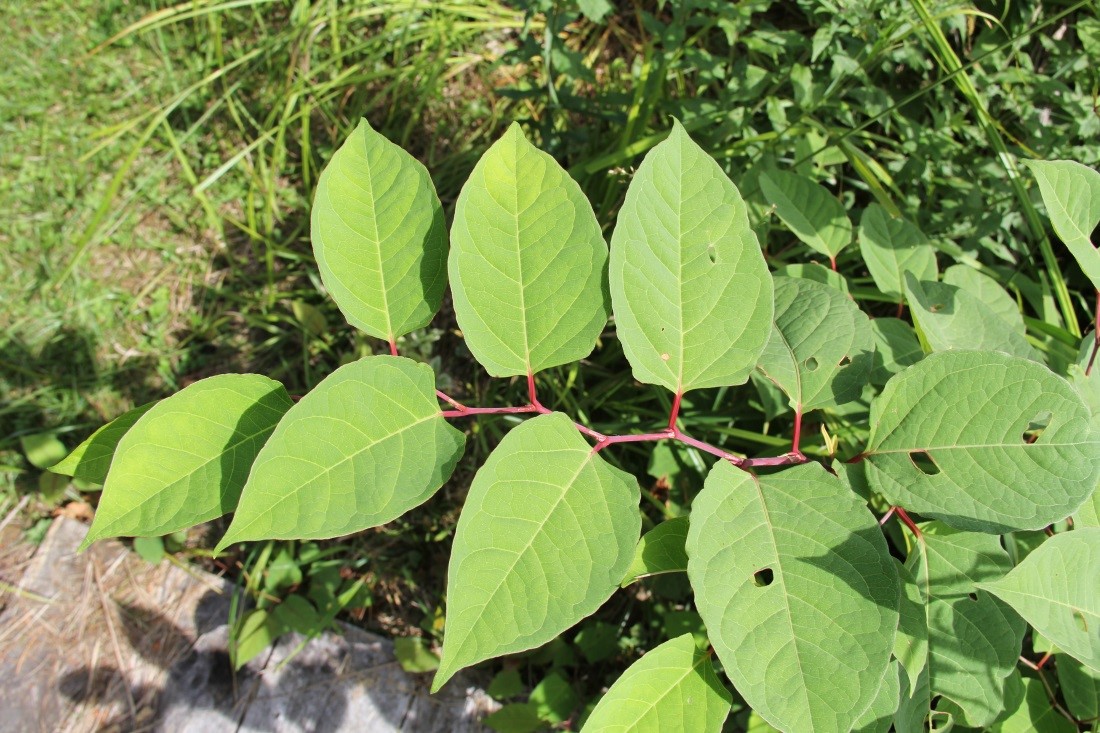
Japanese Knotweed, showing alternate leaves with general tear-drop shape and flattened base, and reddish twigs.
Name: Japanese Knotweed (Fallopia japonica)
General Information: Japanese Knotweed is a semi-woody perennial plant that is often mistaken for bamboo. It is native to Eastern Asia, and was first introduced to North America as a horticultural plant in the 1800’s. Japanese Knotweed is a particularly persistent invasive species due in part to its vigorous root (rhizome) system. Japanese Knotweed can grow in a range of habitats, including open sunny sites, ditches or disturbed areas, riparian areas and in the forest understory. In Algonquin Park’s mixed and deciduous forests, large stands of Knotweed could outcompete most forest wildflowers, shrubs, and tree seedlings. Typically native plants cannot regenerate underneath established stands of Knotweed. Over time, the lack of tree regeneration could result in loss of tree canopy and a more open forest; in the short-term, knotweed will exclude any native shrubs or herbs from growing, thereby decreasing habitat capacity for wildlife.
Japanese Knotweed can easily be spread along ditches or waterways, where pieces of rhizome or stem can be dispersed by moving water. More typically in Algonquin Park, Knotweed could be spread by people moving plant material or improperly disposing of plants, and by heavy equipment that has not been properly cleaned and contains plant parts that then become established.
Identification: Leaves are alternate, typically bright green, tear-drop shaped with a flattened base. Twigs can be green or reddish in a zig-zag pattern. Stems are round, light green with reddish-purple markings (during growth) or brown and brittle (previous year’s growth), smooth, and resemble bamboo. Knotweed typically flowers in late summer/early fall, and has many sprays of tiny greenish-white flowers clustered on a stalk. There are no native species that look similar to Japanese Knotweed.
Control: A variety of means can be used to control Japanese Knotweed, but the initial effort should always be towards limiting the spread of established populations and eliminating satellite populations. The rhizomes of this plant are extremely persistent, and cutting of aboveground vegetation will likely result in regrowth. However, repeated cutting throughout the growing season can be used to control the species, and cutting over several years can significantly weaken the rhizome system. Digging up and removing the rhizomes along with aboveground vegetation can be effective, but follow-up treatments will likely be required. Ultimately both the aboveground vegetation and rhizomes need to be controlled. Some plants may require herbicide treatment for successful eradication. Upon discovering Japanese Knotweed, notify Ontario Parks at algonquin.cottages@ontario.ca or 705-645-7436 so that a plan for control can be made.
Japanese Knotweed is regulated as a restricted species under the Ontario Invasive Species Act, 2015 (https://www.ontario.ca/laws/statute/s15022). Under the act, a restricted species is prohibited from being brought into a provincial park, and prohibited from being deposited or released in Ontario.
Information sources:
Ontario’s Invading Species Awareness Program: Japanese Knotweed
http://www.invadingspecies.com/invaders/plants-terrestrial/japanese-knotweed/
Best Management Practices in Ontario: Japanese Knotweed
http://www.ontarioinvasiveplants.ca/wp-content/uploads/2016/06/OIPC_BMP_JapaneseKnotweed.pdf
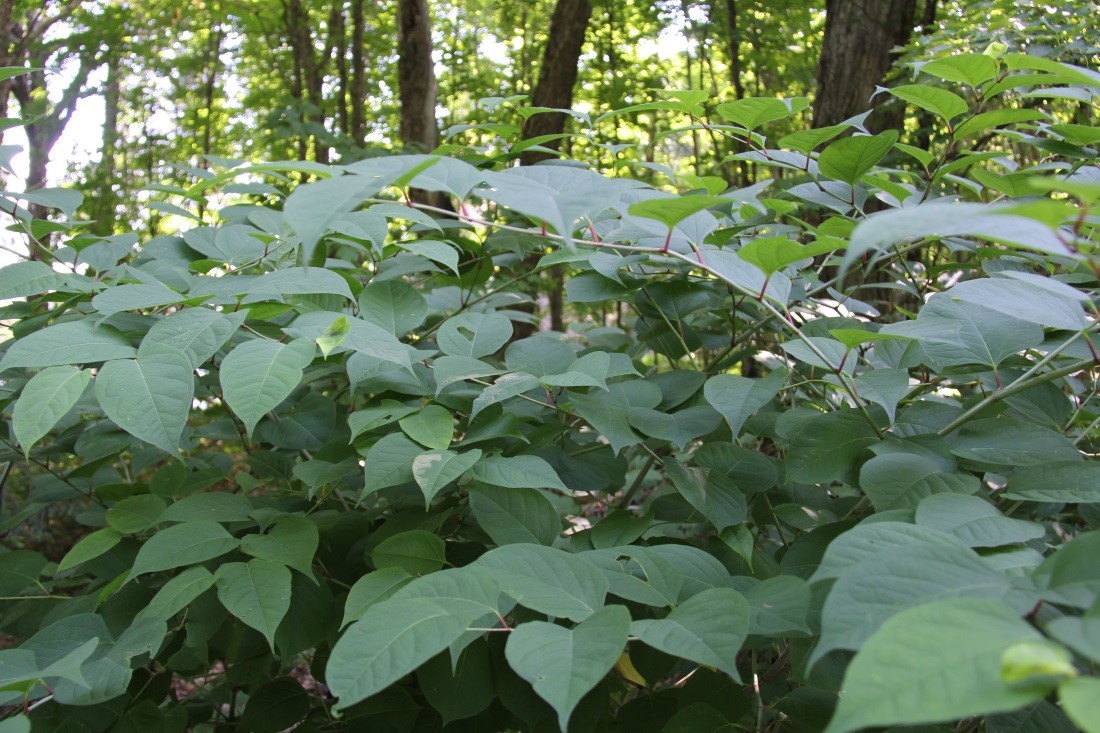
Japanese Knotweed growing along a forest edge in Algonquin Provincial Park.
2.2 Phragmites
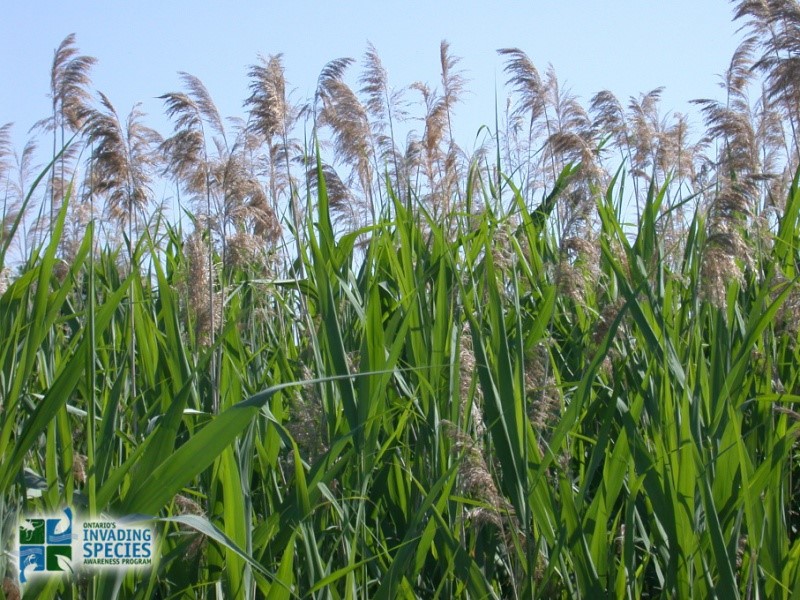
The Common Reed, Phragmites australis, showing typical growth pattern and large, dense seedheads. Source: Ontario’s Invading Species Awareness Program. Photo: Wasyl Bakowsky
Name: Common Reed (Phragmites australis subsp. australis)
General Information: The Common Reed, also known by its Latin name Phragmites, is a very common and highly invasive perennial grass. It grows in disturbed areas, along roadsides, in ditches, as well as along stream banks and on beaches. Phragmites grows aggressively, out-competing native vegetation for nutrients and water, often leading to a decline in biodiversity.
Phragmites can grow quickly into dense stands choking out native plant species. Because it consumes more water than most native species, it can cause localized drying of the substrate, which further impacts native vegetation communities. Although it prefers wet areas, the root network can be extensive, allowing it to survive in fairly dry areas as well. Much of the biomass of a Phragmites plant is underground in the root system. This plant is capable of spreading through seed dispersal and vegetatively by way of the root system which extends out with horizontal runners called rhizomes. Rhizomes can grow several meters per year, allowing patches of Phragmites to spread and increase in size rapidly. Most isolated patches of Phragmites are a result of human actions, usually the use of contaminated equipment. Seeds, or fragments of rhizomes from invaded areas get stuck to vehicles, ATVs, or construction equipment and are then introduced to disturbed other areas, causing new invasions.
Identification: The one challenge to identifying invasive Phragmites is that there is a very similar native subspecies, Phragmites a. subsp. americanus. Compared with the invasive variety, naitve Phragmites a. americanus is relatively uncommon. Nearly all occurrences of Phragmites associated with disturbed areas in the park are the invasive subspecies. The invasive Phragmites has stems that are tan or light brown in colour, leaves that are a green to blue-green in colour, and dense feathery seed heads. In the right conditions Phragmites can grow to 5 meters in height.
Control: Eradicating patches of Phragmites may take several years to complete, as the plant will regrow from a single rhizome fragment. Digging up the rhizome network and removing all aboveground biomass can be labour intensive, but an effective first step in controlling this species. If regrowth occurs, then these remnant patches also need to be eradicated quickly or the plant will recolonize the original area. Some plants may require herbicide treatment for successful eradication. Contact Ontario Parks for further information.
Phragmites is regulated as a restricted species under the Ontario Invasive Species Act, 2015 (https://www.ontario.ca/laws/statute/s15022). Under the act, a restricted species is prohibited from being brought into a provincial park, and prohibited from being deposited or released in Ontario.
Information sources:
Ontario’s Invading Species Awareness Program: Invasive Phragmites
http://www.invadingspecies.com/invaders/plants-terrestrial/invasive-phragmites/
Best Management Practices in Ontario: Invasive Phragmites
http://www.ontarioinvasiveplants.ca.php56-30.ord1-1.websitetestlink.com/wp-content/uploads/2016/07/Phragmites_BMP_FINAL.pdf
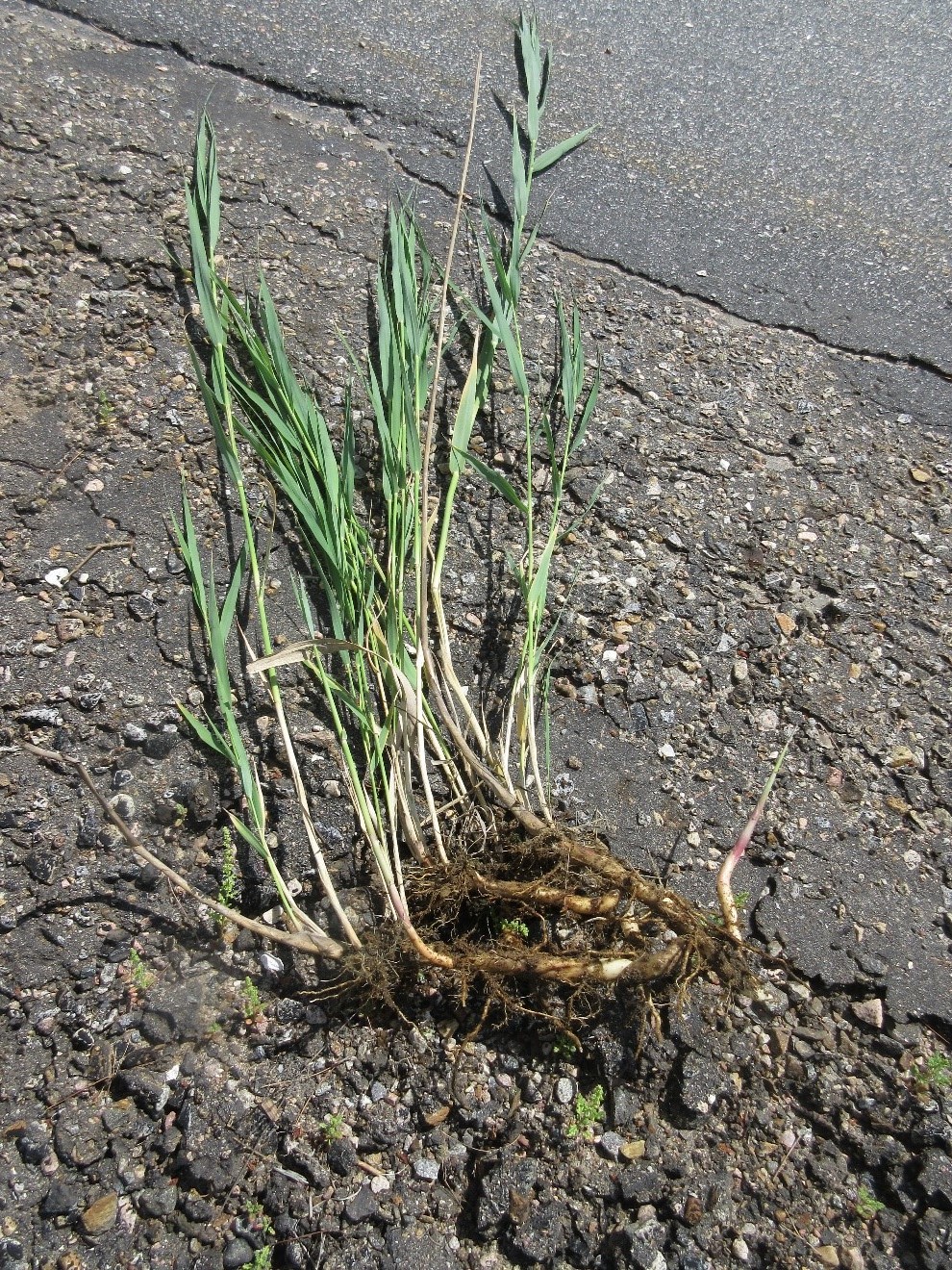
Phragmites removed from Hwy 60 in Algonquin Provincial Park showing extensive root growth connecting above ground vegetation. Photo: Alison Lake
2.3 Dog-strangling Vine
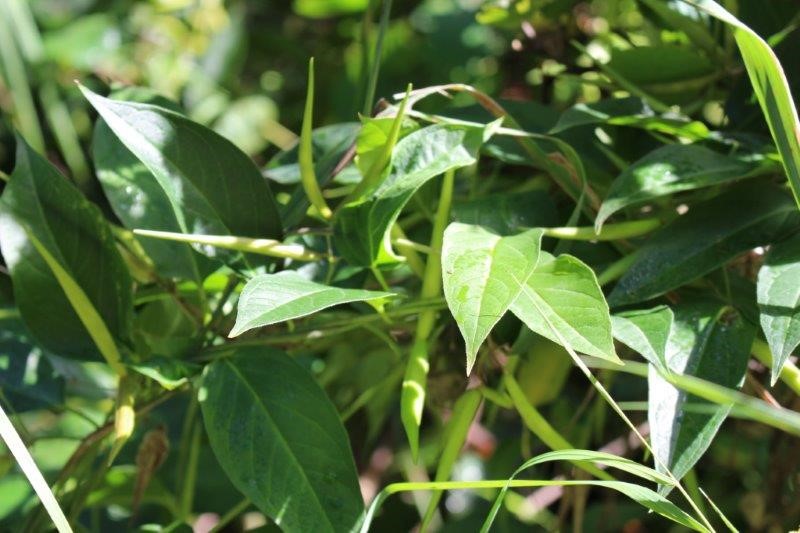
Dog-strangling Vine, showing seed pods and oval leaves with pointed tips. Photo: Derek Lavallee
Name: Dog-strangling Vine (Vincetoxicum rossicum)
General Information: Dog-strangling Vine is a perennial herbaceous plant in the milkweed family (Asclepiadaceae) that is native to southern Europe. It can spread rapidly and form thick mats of vegetation that outcompete native plants for sunlight, water, and nutrients. It can grow aggressively and climb up to 2 meters in height by wrapping (twining) around trees and vertical structures. There is evidence that Dog-strangling Vine is allelopathic, meaning that it produces chemicals that inhibit the growth of nearby plants. Deer and other browsing animals avoid eating Dog-strangling Vine, which may then increase browsing pressure on native plant species. Monarch Butterflies can also be affected because they may mistakenly lay eggs on Dog-strangling Vine, where the larvae will not survive, instead of on native milkweed species which is their intended host plant.
Dog-strangling Vine can grow in a wide range of habitats; it prefers sunny conditions but also grows well in partial shade. It can typically be found growing along roadsides, fence lines, utility corridors, and stream banks. It can even invade closed-canopy forests where it may become the dominant ground cover, and inhibit forest regeneration. Dog-strangling Vine can grow to be so dense that it becomes difficult to walk through and can also interfere with other recreational activities. Seeds of the Dog-strangling Vine can be spread short distances by wind, or long distances by humans, animals or vehicles on which they have become attached.
Identification: Leaves are opposite, smooth, green, oval with a pointed tip, and approximately 7-12 cm long and 5-7 cm wide. The stems can have fine hairs present, and characteristically climb available structures or twine around themselves. Plants with stems twined around themselves can form dense mats of vegetation. Pink to rusty-red coloured flowers with 5 petals each are produced in early summer, with 5-20 flowers in a cluster produced at the leaf axils. In late summer long, slender fruit pods form that are approximately 4-7 cm long and 0.5 cm wide. The pods exude a milky sap when broken, and turn from green to light brown as they age. Similar to other species in the milkweed family, mature seeds are attached to tufts of feathery hair that aid in distribution on the wind. Although there are some similarities in appearances between Dog-strangling Vine and other milkweed species (e.g. Swamp Milkweed, Asclepias incarnata), only Dog-strangling Vine twines (coils around something) as it grows.
Control: Dog-strangling Vine is a persistent invasive species and initial efforts should be focussed on limiting the spread of established populations and eliminating satellite populations. Simple approaches may include picking fruit pods from the plant before they mature to limit natural seed dispersal, but more effective methods will require cutting/digging, and removing the plant material. Some plants may require herbicide treatment for successful eradication; contact Ontario Parks for further information.
Dog-strangling Vine is regulated as a restricted species under the Ontario Invasive Species Act, 2015 (https://www.ontario.ca/laws/statute/s15022). Under the act, a restricted species is prohibited from being brought into a provincial park, and prohibited from being deposited or released in Ontario.
Information sources:
Ontario’s Invading Species Awareness Program: Dog-strangling Vine
http://www.invadingspecies.com/invaders/plants-terrestrial/dog-strangling-vine/
Best Management Practices in Ontario: Dog-strangling Vine
http://www.ontarioinvasiveplants.ca/wp-content/uploads/2016/06/OIPC_BMP_DogStranglingVine.pdf
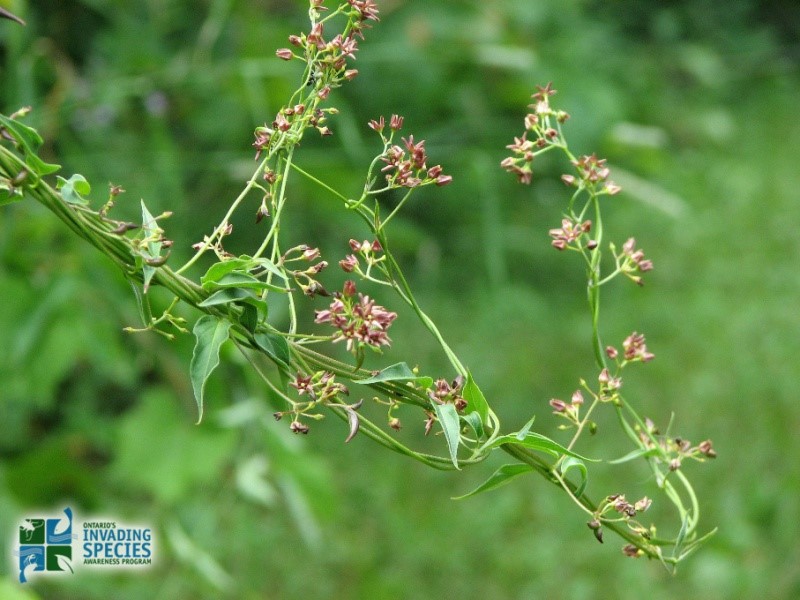
Dog-strangling Vine, showing pink star-shaped flowers and the twining character of the stems. Source: Ontario’s Invading Species Awareness Program, Photo: Ken Towle
2.4 Goutweed
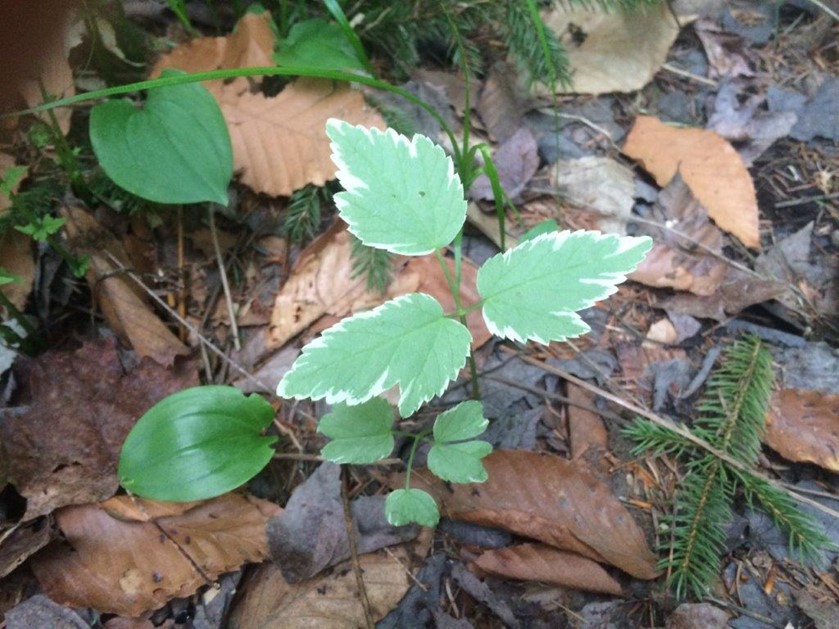
Single Goutweed plant, showing compound leaves and variegated colouration. Photo: Sandy Dobbyn
Name: Goutweed (Aegopodium podagraria)
General Information: Goutweed is a common invasive groundcover that was originally introduced to North America as an ornamental plant. Goutweed creates dense carpets of vegetation that restrict the amount of sunlight available for native species. Unlike other groundcovers, Goutweed does not climb.
Goutweed gained some popularity as an ornamental plant because it provides abundant groundcover in shaded or partially-shaded environments, requires little maintenance, and spreads without much encouragement. However, these same characteristics make it a persistent invasive species that can establish itself in the forest understory and disrupt the native plant diversity.
Identification: Goutweed has a compound leaf with serrated edges that are alternate on the stem, and can be either solid green or variegated with white edges. Goutweed flowers from June to August, producing small white flowers in compound umbels which appear umbrella-like on the stem. It is a perennial plant that reproduces by seed or through underground rhizomes.
Control: The extensive rhizome network of Goutweed allows it to regrow quickly after cutting, and presents challenges for eradication. Digging up the plant, including the entire root network, can be effective but needs to be done meticulously because the plant can regrow from a single root fragment. This may need to be done over several years before eradication is complete. Small patches of Goutweed could also be covered with a tarp for a growing season. Some plants may require herbicide treatment for successful eradication; contact Ontario Parks for further information.
Information sources:
Ontario’s Invading Species Awareness Program: Invasive Ground Covers
http://www.invadingspecies.com/invaders/plants-terrestrial/invasive-ground-covers/
Ontario Weeds: Goutweed
http://www.omafra.gov.on.ca/english/crops/facts/ontweeds/goutweed.htm
2.5 Periwinkle
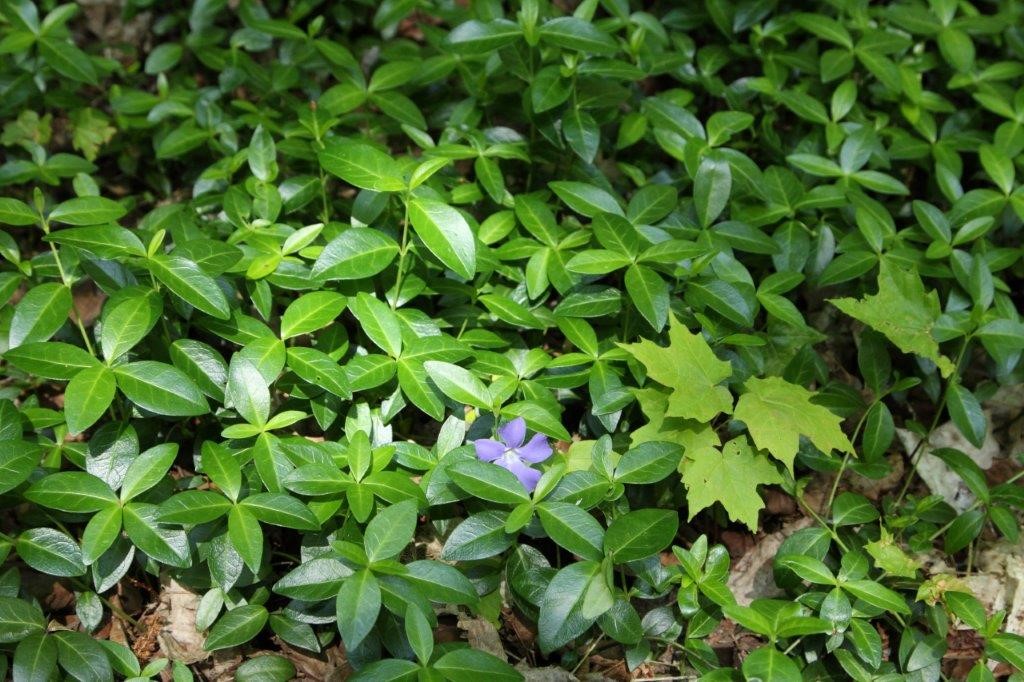
Periwinkle showing opposite leaf arrangement, dark shiny leaves and violet purple flower. Photo: Sandy Dobbyn
Name: Periwinkle (Vinca minor)
General Information: Periwinkle is a common non-native plant that is often used as groundcover. It is native to the Mediterranean basin and was introduced to North America as an ornamental plant. It easily escapes cultivation and is considered highly invasive. Periwinkle, like many other invasive plants, reproduces through vegetative propagation, where new plants grow from the roots of an original plant. Periwinkle poses a threat to biodiversity because it spreads over large areas and competes with native plant species in a number of habitats. It can grow in a variety of light and moisture regimes, but can thrive in low-light and high-moisture conditions which makes Periwinkle particularly damaging to plant communities in the forest understory. Periwinkle is still sold at some plant nurseries, so this is an existing source contributing to the invasion of this plant across the province.
Identification: Periwinkle leaves are dark green and shiny in appearance, and grow opposite on the stem. It has violet to purple flowers with 5 petals that appear in early spring. It has a slender stem that can grow over a meter along the ground but often not more than 15 cm tall.
Control: The most effective effort in preventing the spread of this plant is to be able to identify it and not introduce it to new areas. Periwinkle can be controlled by digging or pulling the plants out, as long as all aboveground vegetation and roots are removed. Some situations may require herbicide treatment for successful eradication; contact Ontario Parks for further information.
Information sources:
Ontario’s Invading Species Awareness Program: Invasive Ground Covers
http://www.invadingspecies.com/invaders/plants-terrestrial/invasive-ground-covers/
2.6 Daylily
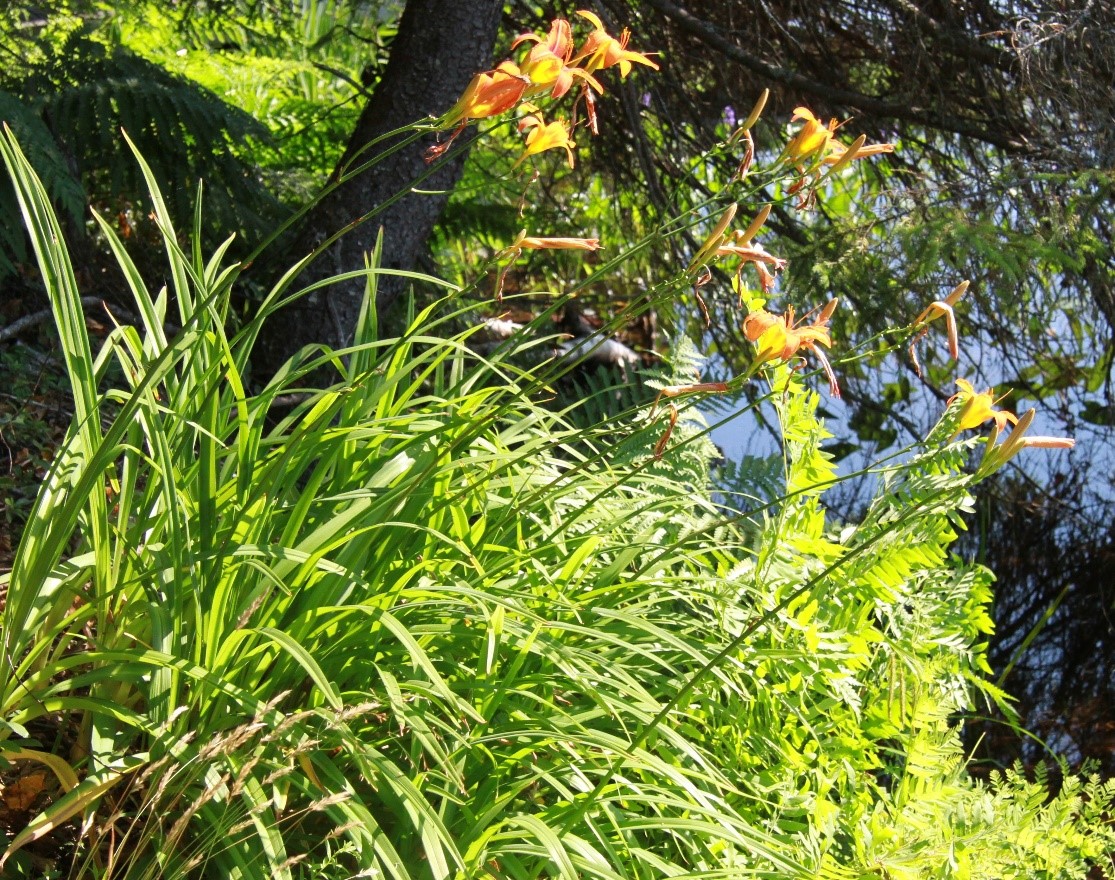
Daylily showing dense growth and striped yellow-orange flowers.
Name: Daylily (Hemerocallis fulva)
General Information: Daylily is a widespread perennial that was introduced from Asia in the early 19th century. It is still a popular garden plant because of its hardiness, ability to spread and showy blooms. This herbaceous forb is commonly seen along roadsides and near old buildings and homes where plants have escaped from gardens into surrounding ecosystems. Once established, Daylilies are capable of displacing native vegetation communities and altering ecosystems where it invades.
Daylilies can thrive in wide range of conditions; from full sun to partial shade, in meadows, floodplains, forests and along forest edges. Daylilies spread from a network of tuberous roots, from which new plants grow. Even fragments of roots left behind during removal have the potential to proliferate. Daylilies also produce large seed capsules and can spread by seed. These traits make Daylily a difficult plant to control and remove.
Identification: Daylily is a bulbous perennial which grows from 0.5 to 1.0 meters tall. The leaves are bright green, long and thin, originating at the base of the plant and arching outward. Daylily blooms in mid to late summer, often with large orange, striped flowers, although there are many cultivars of different colours including variations of white, pink, yellow and red. Flowers develop on a long stalk in clusters of 5 to 9. The flowers open one at a time and last for just one day before they close and dry up. By late summer, large capsules develop at the ends of the stalks, each containing roughly 5 to 12 dark coloured seeds.
Control: A variety of means can be used to control Daylilies. As with all invasive species, prevention is best. Where Daylily is already present, an effort to identify the extent of its distribution is an important first step. Once the extent of spread is known, digging up the plants is usually the most efficient option. Digging the plant up with a shovel while being sure to remove as much of the tuberous root system as possible is the best way to control this plant. Daylilies are capable of regrowth from even a small piece of root, so follow-up monitoring of areas where plants have been removed is critical to ensuring that it is totally eradicated.
Information sources:
Plant Invaders of Mid-Atlantic Natural Areas, 4th ed. (2010):
https://www.nps.gov/plants/alien/pubs/midatlantic/midatlanticprint.htm